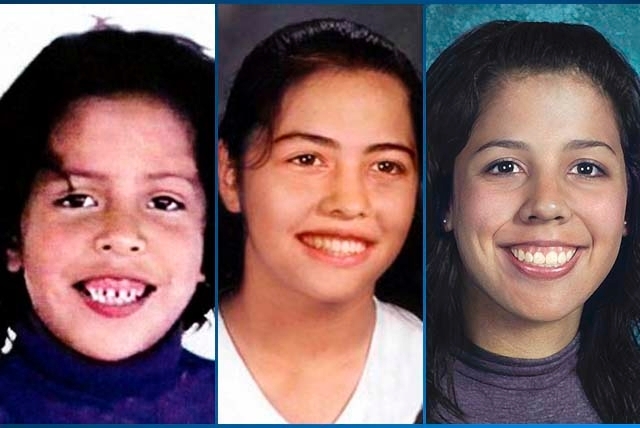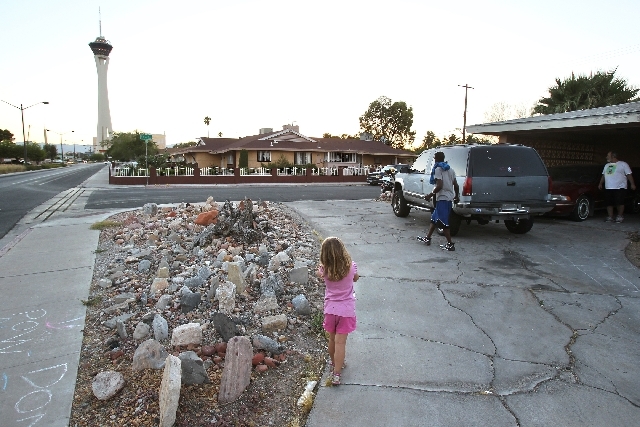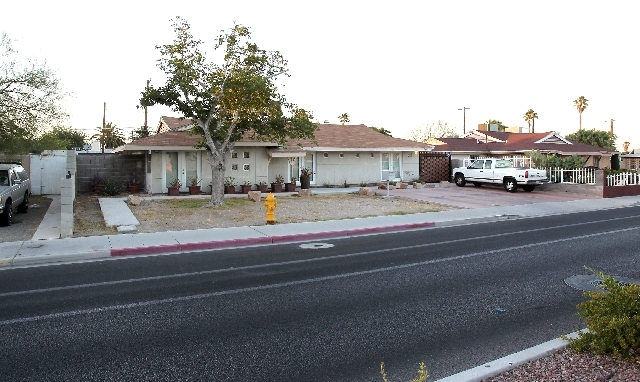Las Vegas girl vanished in 1999, leaving grieving family, frustrated police
There is nothing ominous about the neighborhood around 705 E. St Louis Ave., where the 7-year-old girl with short black hair and a toothy smile often roamed on her bike.
Two churches are within sight of her home, and Nevada’s oldest women’s club is directly across the street. The family didn’t live in a cul-de-sac hidden behind high walls and a gate, but their windows weren’t sealed off with steel bars, either.
Karla Rodriguez wasn’t afraid to be a kid in this neighborhood, and her busy, yet loving, parents weren’t afraid to let her.
But one October night in 1999, someone was watching.
Maybe it happened in a few seconds. Maybe she was stalked for a few hours.
Whoever took Karla had plenty of opportunities that day, Oct. 20, 1999, which began like so many others in the Rodriguez house.
Karla walked with her mother, Elia, to Park Elementary School, a few blocks from their home.
They were met halfway by Karla’s classmates, and Elia went home to rest before going to work that afternoon.
Her father, Ramon, returned from work about 3 p.m., and Karla wasn’t there. Her bike, which police said she “lived on” after school, was still at the house.
“She’s around here somewhere,” Karla’s sisters told their father.
Ramon left for a meeting and returned at 5 p.m. Karla was still not home. But now her bike was missing, too.
Ramon wasn’t panicked. It wasn’t unusual for Karla to explore on her own. He drove the family’s only car to his wife’s workplace, dropped it off for her, and rode the bus home.
And he was right — Karla was OK. For awhile, anyway. Ramon spoke to a neighbor on Bonita Avenue, just around the corner, who saw Karla on her bike about 7 p.m.
Karla wanted to visit the neighbor’s son, a playmate. But it was too late, and the neighbor told her to go home. It was dark and getting cold.
Karla played outside for about 15 minutes before leaving, the neighbor said.
“And then Karla’s gone. And she hasn’t been seen since,” Detective Dan Holley said.
‘OUR CRIME, OUR CURSE’
There are few Las Vegas police officers with more experience than Holley, a 30-year veteran, including seven in missing persons.
There are even fewer with his flair for explaining police theories and recalling quirky details of old cases.
Every person is different, but even the squeaky clean folks are creatures of habit, Holley says. Those habits are often bad for us — alcohol, gambling, fatty foods — but people return to what’s familiar.
“We all cycle. Whatever our niche is — our crime, our curse — whatever it may be. Whether it’s a chocolate bar, or chocolate cake, or a child molester,” Holley said, four heavy boxes holding the Karla Rodriguez file next to him.
“So you gorge yourself on chocolate cake, which is the only time that you swear it off, right? You’re sick of that big fat chocolate cake.
“A week later, two weeks later, a month later, you find yourself at the bakery. Or in front of a school.”
“Stranger abduction” has been the department’s working theory in Karla’s case for more than a decade.
The girl’s immediate family was cleared long ago.
Holley said it’s likely Karla was abducted. It’s the only idea that makes sense to police; little girls don’t just disappear into thin air.
A random abduction is incredibly rare in these cases, but for some offenders, children are part of their “cycle” — their “curse.”
“I strongly believe that no child molester wants to be a child molester, or a taker of children,’’ Holley said. “I bet they hate themselves. I bet they swear it off, after they do it, but pretty soon? They’re in front of a school.”
PRESERVATION OF LIFE
Las Vegas has hundreds of missing persons cases open for longer than 60 days, but Karla Rodriguez’s file is the biggest.
“There are people calling in today about a person who went missing in the ’40s,” Holley said. “They file a report and you do what you can.”
Holley could use help. But in a department that sometimes receives 900 missing person reports a month, and with some detectives working eight cases a day, police must prioritize.
Many people who “disappear” in Las Vegas do so willingly, though it can be difficult for some families to understand, Holley said.
“They think that their 47-year-old son, who hasn’t called them, is as important as an 8-year-old who didn’t come home from school,” he said. “Our job here is preservation of life. That’s our No. 1 responsibility.”
Detectives never stop working missing person cases involving children, no matter how old.
Most of the work in Karla’s case was done years ago, when her disappearance was fresh. But Holley and another detective recently began combing through the file again.
“It was just time,” he said.
Officers in 1999 were at an immediate disadvantage, Holley said, because Karla wasn’t reported missing for hours after her neighbor last saw her.
After speaking with the neighbor, Ramon went home to bed, thinking Karla was staying at a friend’s house, Holley said.
It wasn’t until the next morning when Elia, in a panic, spoke to her daughter’s school principal. The principal was the first to call police.
“It’s odd that a 7-year-old isn’t home, and then you go to bed,’’ Holley said. “That’s odd. Is that something that’s been explored? Oh yeah.”
A local task force canvassed the neighborhood around Maryland Parkway and St. Louis Avenue, a mile east of the Stratosphere. There were plenty of tips and leads, but no success.
Detective Roberto Juarez had Karla’s case for about a decade, dropping the assignment only after leaving the missing persons section a few months ago. The search for Karla was a statewide effort, Holley said, but the burden was heaviest for Juarez, the primary detective for years.
“He’s that cliche, the teary-eyed cop standing out there in the middle of the street, like, ‘Where the hell’s Karla?’ I mean, he’s the real deal. He lived it every day,” Holley said.
Juarez deferred all questions to those who came after him. Holley and Detective Art Martinez have taken over where Juarez stopped.
Martinez understands Mexican culture and might spot a clue Holley could miss, the detectives said.
“Every culture is different, although the morals could be the same,” Martinez said.
A HOUSE IN CLEVELAND
Rosy Rodriguez, one of Karla’s three sisters, was 15 when her sister disappeared. Now she is 28, and most memories of Karla are overshadowed by the worst moment in her family’s history.
Rosy only sees her sister grow up in age-progression photos provided by the National Center for Missing & Exploited Children.
But the family has never given up hope, Rosy said.
“We have our feeling that she’s out there, you know? You just have to have a lot of hope and faith. Until we have some news, we’re holding tight,” she said.
Shocking headlines about three women found alive in a Cleveland house a decade after they were kidnapped give a reason to never stop believing, Rosy said.
“Every time we see cases like that, our hope grows. And our faith. We know that we might be one of the families that has news like that in a couple years.”
The differences between Las Vegas and Cleveland are stark, which may help explain how much attention the stories received in each city.
Amanda Berry and Gina DeJesus, two girls Ariel Castro is accused of kidnapping, received extensive media attention in Cleveland. Members of their communities rallied around the families and held annual vigils, keeping their names in the news.
FINDING HOPE
It hasn’t been that way for Karla in Las Vegas.
Ivet Santiago, executive director for Nevada Child Seekers, said her organization sends yearly reminders on the anniversary of the disappearance, but only local Spanish media run stories.
The same holds true with Everlyse Cabrera, a 2-year-old girl who disappeared on June 10, 2006. Her foster parents told police the girl let herself out of their North Las Vegas home sometime in the night.
A missing white child receives much more attention than a missing Hispanic or black child, Santiago said.
“That is troubling for all of us. That needs to stop. We need to send a message to media that all of our kids deserve the same amount of recognition.”
Las Vegas is a transient city where people often don’t know their neighbors or identify with the community, Santiago said.
“Taking our community versus the community in Ohio, those folks there have been there generations. It’s tight-knit,” she said.
David Routsong, who owned the house next to the Rodriguez family from 1997 to 2004, proves her point.
“I owned the place for quite a few years,” he said. “I don’t recall that (disappearance) happening.”
Holley said he doubts there is a prison house in Las Vegas like the one in Cleveland, but he wouldn’t rule it out. In fact, he won’t rule anything out.
“We will follow a psychic. I mean, at the end of the day, when everything else is done that makes any sense at all, when every logical lead has been bled out, we won’t tell nobody, but we’ll go out there, look under a rock, behind a tree, where the river goes by,” he said. “Whatever it may be.”
As for the Rodriguez family, they are still waiting for their break.
Karla’s parents have since welcomed a new member to their family, a little brother, who has yet to meet one of his sisters.
Without a resolution, the family will never have peace, Rosy said.
“It’s amazing how people can wait like this, and go on with their lives. It’s not easy, trust me,” she said. “It’s not easy having a member of your family missing. It’s horrible, and nobody deserves this.”
Anyone with information about Karla is asked to call the Las Vegas missing persons section at 702-828-2907.
Contact reporter Mike Blasky at mblasky@reviewjournal.com or 702-383-0283. Follow @blasky on Twitter.



















